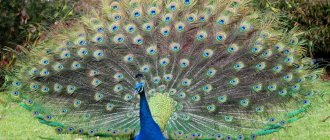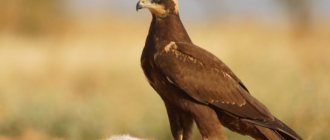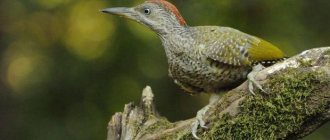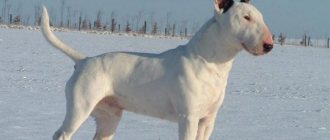- Wild animals
- >>
- Insects
The woodcutter beetle is a prominent representative of the Coleoptera order, famous for its huge mustache. Due to its external features, it is often also called barbel. This insect mainly lives in tropical countries, but is represented on almost all continents. It has more than twenty-five thousand varieties. And this is not the final figure. Every year, scientists discover more and more new species of longhorned beetles.
Origin of the species and description
Photo: Lumberjack Beetle
Lumberjacks are a very large family of beetles. They belong to the order Coleoptera and occupy fifth place in the number of species. As already noted, today scientists count more than twenty-five thousand varieties. The beetles got their name “woodcutter” due to their special “love” for wood. They not only eat wood, but also build their homes in it.
Interesting fact: The Titan Lumberjack is recognized as the largest beetle in the world. The length of its body can reach twenty-two centimeters. However, such a huge insect cannot be found in museums. The individuals presented for public viewing are no more than seventeen centimeters long.
Due to the fact that the wood is consumed by these beetles as food, they are considered pests. These insects cause enormous damage to human property, various buildings, and the environment. This multifaceted creature is distributed almost throughout the globe. The only exceptions are very cold areas of planet Earth. The largest populations are found in tropical regions.
A unique feature of these animals is their mustache. They are segmented, most often exceeding the length of the body itself by several times. Also a characteristic feature are the wings. However, not all members of the family can use them. Only a few species are endowed with the ability to fly. Woodcutter beetles, which are large in size, often look very clumsy when flying.
Appearance and features
Photo: Insect woodcutter beetle
Most representatives of lumberjacks have average body dimensions. Only a small number belong to the group of giants - these are titanium and bigtooth. Their average length is 167 millimeters. Such animals live mainly in Young America. Beetles from Fiji are smaller in size. Their length can reach fifteen centimeters. The carpenter's barbel (up to 6 centimeters) is a giant among European species, the relict barbel (up to 11 centimeters) is a large representative of the order living in Russia.
Video: Lumberjack Beetle
A significant part of the insect's length is occupied by the whiskers. Sometimes they exceed the body length by four to five times. The body of the woodcutter beetle is slender, slightly elongated. There may be various spots and stripes on it.
The colors come in a variety of colors:
- gray-blue;
- black-brown;
- greenish;
- white;
- mother-of-pearl;
- pale yellow.
Interesting fact: Among the adult woodcutter beetles there are atypical species. One of them is the Parandra barbel. It has small dimensions and is considered the most primitive. The body of such an insect is flat and very wide. For this reason, it is often confused with stag.
Lumberjacks can make various sounds. The sound is produced by the friction of the rib on the surface of the mesothorax. The sound is creaking, not very pleasant. Beetles use it as protection. The sound is made in the event of an enemy attack; it is of a frightening nature.
Where does the woodcutter beetle live?
Photo: Relic woodcutter beetle
The longhorned beetle can thrive almost anywhere there is wood. The only exception is regions with too low temperatures. The favorite tree species of such insects are conifers. However, they also live in other trees, shrubs and even herbaceous plants. Sometimes insects choose country houses and dachas to live. They can feed on wooden furniture and building elements, which causes great harm.
The largest representative of the family, the titanium beetle lives in Colombia, Peru, Ecuador, and Venezuela. They settle in the Amazon River basin. Residents of these countries sometimes independently attract such insects to their homes, then sell them for huge sums. The demand for titan beetles is very high among collectors.
In European countries, Iran, Turkey, Western Asia, the Caucasus and the Urals, woodcutter beetles live in large populations. They also live in Moscow. Animals choose deciduous, mixed forests to live. They settle in dead trees. In general, about five hundred species of longhorned beetles live in Russia. Other species of the woodcutter beetle are present on almost all continents. They live in Poland, Belarus, Ukraine, and Moldova.
What does the woodcutter beetle eat?
Photo: Big woodcutter beetle
The main diet of woodcutter beetles consists of leaves, pollen, and needles. Some members of the genus prefer to eat only juice. The bark on young branches becomes food less often. Middle-aged individuals feed on it. The bark of young twigs is a “diet” food. It helps the germ cells mature.
The black house woodcutter brings great harm to humanity. It inhabits building materials, furniture, and wooden elements of residential and commercial buildings. Such beetles not only make cracks for themselves to live there, but also lay larvae in them. There have been cases in the world when barbel larvae almost completely destroyed wooden houses in entire neighborhoods.
The larvae's diet consists mainly of dead wood. This is due to the fact that a living tree has too little protein. Protein is necessary for larvae to grow and develop. In rotting trees, where fungi have developed, there is much more of this necessary protein.
Interesting fact: There are adult woodcutter beetles in the world that do not eat food at all.
An example of insects that can survive without food is the titan beetle. It lives off the nutrients that it was able to accumulate while still in the larval stage. Beetles tolerate a period of starvation absolutely normally. And the entire adult period does not last long - only a couple of weeks.
Sexual dimorphism
Most often, males have longer mustaches than females, and the upper jaws are more elongated. Their abdomen is sharper. The color is also different.
Dimorphism can be so strong that females and males of the same species can be completely different. Females have a more massive and larger body. There are also differences in the size and shape of the pronotum.
Adults feed on needles, leaves and pollen; sometimes they can eat the bark. They begin to eat the bark before the mating season, this precedes the development of germ cells. Many lumberjacks flock to the flowing tree sap.
Woodcutter beetles feed on tree bark and tree sap.
Features of character and lifestyle
Photo: Lumberjack Beetle Red Book
Lifestyle and rhythm of life depend on a number of factors:
- location;
- climate, weather conditions in the region;
- food quality;
- gender
Adult beetles living in the southern regions begin to be active in mid-spring. The woodcutter beetle flies in Central Asian territory only in early autumn. Rare members of the family lead a diurnal lifestyle, feeding on flowers. Other species prefer to fly, breed and feed in the dark.
Most adult longhorned beetles spend their time hidden during the day. There they rest and eat. Such insects fly extremely rarely. This is due to the large dimensions of the body. It is difficult for such bugs to take off and land softly. Only some of the flying species can carry out long flights. At the same time, in some species females fly more, in others - males.
The woodcutter beetle is an insect with a terrifying appearance. However, it does virtually no physical damage to humans. The barbel does not bite unnecessarily and has a calm character. History knows only a tiny number of such incidents. And the bite itself is not dangerous to humans. It heals quickly.
Social structure and reproduction
Photo: Lumberjack Beetle
Female lumberjacks lay eggs in the spring. For breeding, they very carefully select a secluded place. This is due to the fact that the place will serve not only as a “roof” over your head, but also as a source of food for the larvae. Most often, eggs are laid in large cracks in wood. Females prefer coniferous species: pine, cedar, spruce. Insects determine the type of tree by its subtle aroma.
Female longhorned beetles can lay varying numbers of eggs. Sometimes their numbers reach several hundred at a time. Two weeks after laying, larvae begin to appear. They are white in color and have an awkward appearance. Longhorn beetle larvae resemble worms and are highly voracious.
Interesting fact: The woodcutter beetle often interbreeds with other species. This leads to the formation of a large number of hybrids.
Woodcutter beetle larvae have strong, powerful jaws and high survival rates. They not only live in wood, but also actively make passages there to search for a new source of food. The appetite of the larvae is monstrous. In large concentrations, they are capable of completely destroying a wooden structure in a short period of time.
Woodcutter beetle larvae live for more than one year. There is a long period before reaching adulthood. For some it is one year, and for some species it is about two years. Adults live a tiny amount of time - no more than twenty-five days.
What happens to the larvae
This can be said about light or milky-colored, fleshy-yellow larvae of a flattened shape. Convex limbs allow future insects to move along the surface. The head is black with healthy jaws. With them they easily gnaw the inside of the tree, so they have enough nutrition. Gradually, only dust remains from the tree trunks. Then the larva will have to look for a new place of “residence”.
Those who live in the grass, on plant stems, have an elongated long body, similar to a cylinder, with hairs at the ends of the body.
Well formed sternum. The gluttony of the larvae is amazing - in a day they can increase their mass to twice their original weight. This law of nature operates to produce a full-fledged beetle, because... on summer days, a mature individual eats practically nothing - just grass and flowers. Moments were noted when bark beetle larvae completely destroyed human wooden buildings located in one block. Autumn is coming to an end. The beginning of winter is the time of pupation of the larvae. Spring is the stage of metamorphosis of a beetle into an adult insect. If the larva is hidden deep in the plant and is reliably protected, then the individual can survive in this state for decades. The fact of drilling a “passage” of up to 50 km has been recorded, taking into account the fact that up to 3 cm of wood is gnawed per day.
The free pupal stage lasts about 40 days. The color of the body changes, yellowness appears, the rudiments of wings and antennae are visible, the limbs are closely pressed. The head is located almost at the chest, the antennae are hidden between the legs. The pupae may have spines and short hairs.
The larva first builds a shelter in a tree trunk, ground, stems, and pupation begins there.
Natural enemies of woodcutter beetles
Photo: Lumberjack beetle
The most dangerous natural enemies of adult woodcutter beetles are woodpeckers. They are the ones who most often attack insects. They are also preyed upon by other bird species. Longhorn beetles often become victims of predatory insects. They are less often attacked by parasitic microorganisms. The latter kill animals slowly but surely.
The larvae live in secluded places, so they are less likely to become victims of natural enemies. They are preyed upon by wasps, parasitic microorganisms and other types of beetles.
Adult woodcutters do not suffer as much from predators and birds as from the hands of humans. Rare species of longhorned beetles, especially large individuals, are in particular danger. In most countries, they are hunted by collectors and exotic lovers. They catch them for their collections or for sale. In America, for example, you can get about a thousand dollars for a woodcutter beetle.
A little bit of biology
Longhorned beetles have fairly small sizes (from one to several tens of millimeters), a flat body and mustaches, which are the main organ of smell. The color of lumberjacks is usually brown or dirty gray; less commonly, the longhorn beetle is black. The photo allows you to examine the insect in more detail.
The larvae of the pest are characterized by particularly powerful jaws, thanks to which they can handle both hard wood and soft metal with a cable-type coating. However, the beetles do not eat the latter so readily, preferring wooden structures and stacked boards.
The female barbel lays her eggs (from 200 to 400 pieces) in recesses or cracks in the tree, and after 7-14 days the larvae are born, which instantly activate the process of destroying the tree.
It is worth emphasizing that it is almost impossible to immediately notice a tree disease, since the larvae lead a hidden lifestyle. So, you can understand that your wooden house has succumbed to the harmful effects of longhorned beetles only when the real results of their work (destroyed and loosening wood) are visible.
Population and species status
Photo: Woodcutter beetle from the Red Book
The woodcutter beetle has about twenty-five thousand species. For this reason, the family cannot be called endangered. The population of such insects in the main area of residence is quite large and is not threatened. However, many species of longhorned beetles are rapidly declining. Some species are even listed in the Red Data Books of European countries.
The following factors influence the decline in the population of certain species of lumberjacks:
- massive deforestation of coniferous forests. Coniferous wood has become increasingly used during construction and furniture making. Uncontrolled logging leads to the destruction of the “homes” of woodcutters;
- catching beetles by collectors. This is due to the high cost of individuals on the market;
- destruction of insects by humans. The woodcutter beetle, especially its larvae, is a pest. Those individuals that settle in houses and dachas are periodically destroyed using special compounds.
How to get rid of longhorned beetle using chemicals
If longhorned beetles are found in the house, you need to immediately take measures to destroy them. In order for wood to last as long as possible, it must be processed before building a house. As a rule, they use a fumigation method based on phosphine gas. If the tree has not been treated, then beetles will definitely appear. Then you will have to do a series of actions.
For example:
- First of all, it is necessary to check the extent of damage to the wood. To do this, take a screwdriver and use it to pierce the wooden structures. If the tool easily fits into the wood, then it is better to replace such structures.
- Those structures that the beetle has not yet reached must be treated with special liquids. Before this, wooden structures are cleaned with a wire brush, after which all dust and sawdust must be removed with a vacuum cleaner. After this, the surfaces are treated with an insecticide. Before this, everyone living in the home is evacuated and the windows and doors are tightly closed.
- In cases of severe infection, syringing is carried out. To do this, holes are drilled in the wood with a thin drill, in increments of 3 cm, and an insecticidal solution is injected into them using a syringe.
There are many products available on the chemical control market to kill all types of insects. In such cases, it is better to choose liquids, since they can penetrate the wood structure and destroy the larvae there.
What types of insecticides are there:
- Contact action . Insects and their larvae die upon contact with the chemical. These products are rarely used, since working with them can cause poisoning.
- Intestinal action . If it enters the intestines of an insect or larva, the substance leads to death. Based on such components, baits are made, which include an insecticide and an aromatic substance to attract insects.
- Fumigants . They emit gases that are toxic to insects.
You can use the following against longhorned beetles:
- Empire-20.
- Tree healer.
- Antibug.
- Antishashelin.
Rules for the use of insecticides
When using insecticides, you must adhere to a number of rules. For example:
- Residual agents are applied to surfaces using spray guns. These substances are practically safe for people and pets, so you can return to the room within a few hours after treatment.
- To treat hard-to-reach places, a different method is used. To do this, holes are drilled and a toxic substance is supplied through a thin tube to the problem area. After this, the hole is filled with wax or paraffin. After some time, the wood will be saturated with the product and the larvae will die. This treatment requires leaving the premises for several days.
- If the walls are made of thick logs, then it is better to use a product such as Lignofix I-Profi. A hole is drilled in each beam, every 5 cm from top to bottom or vice versa. The distance between the rows is up to 1 m. Then a syringe is taken and insecticide is applied to each hole. After some time, when the product is absorbed into the wood, the operation should be carried out a couple more times. After completion of the procedure, the holes are sealed with sealant.
- When buying a remedy for longhorned beetles, you need to make sure that the product will help, since it is intended specifically for such purposes.











